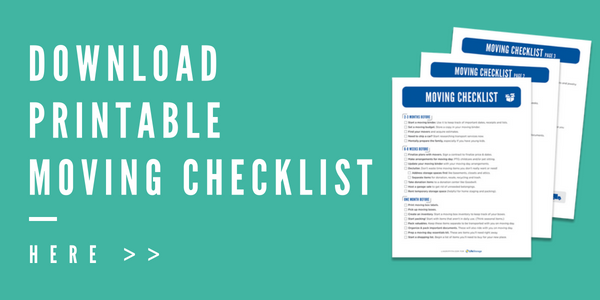
Sometimes, life doesn’t go as planned. Let’s say, for whatever reason, you’ve found yourself moving back home with your parents in the house or town you grew up in. Maybe you’re moving back home after graduating college to save money and find a full-time job. On the other hand, you might be making a career change in your mid-twenties or just re-configuring all of your life plans in your thirties.
Whatever the case, know that moving back home with your parents doesn’t have to be a source of shame. In fact, more people than ever before are deciding to return to the nest to regroup, strategize, and eventually head back out into the world to tackle their goals. According to a Pew Research Study, the number of young folks moving back in with their parents has been at an all-time high in the past 50 years! As the old adage goes, sometimes you need to take one step back to take two steps forward.
Related: Best Packing and Moving Tips: How to Make Relocating Less Stressful
Your Guide to Moving Back Home
Regardless of why you want to move back home, make sure you don’t rush back into it without first deciding if it’s the best decision for you. That includes all aspects of your life, including finances, social life, career, and mental health. Take the time to weigh some pros and cons. If you do opt to move back home, make sure you discuss it thoroughly with your parents, guardians, or any other family members you’ll be living with.
In this article, we’ll outline some of the most important topics to consider before making the decision to move back in with your parents in your hometown. You’ll want to read through each section and do some long, hard thinking before you pack even a single moving box:
1. Acknowledge the pros and cons of moving back home
When it comes to moving back in with your parents, everyone’s circumstances will be different. Your age, location, occupation, family dynamics, and other factors all play a huge role in your experience moving back home. That’s on top of the fact that whatever is bringing you home might be a heavy emotional burden to process, which will, without a doubt, make this transition even more difficult. Other times, the decision is strictly a financial or logistical one without so much emotional weight.
Regardless, listing all the pros and cons of moving back home is essential. Here are some examples to get you started.
What are the pros of moving back home?
- Your childhood home can serve as a secure base to work on future goals.
- It’s easier to save money when living at home, either for free or a discounted rent.
- Moving back home can be highly beneficial during financial or health crises. You might need to help support your parents or vice versa.
- If you get along well with your parents, siblings, or other family members living under the same roof, this can be a great way to spend more time together, strengthen your bonds, and make memories you wouldn’t have made otherwise.
- Living alone during difficult times can be scary, emotionally exhausting, and just plain lonely. If nothing else, it might help to have a few more people around to offer emotional support when you or someone you love is struggling.
- Does your family live in or near a big city or metro area? You may be able to take advantage of a better job market or access a wider variety of amenities than before.
What are the cons of moving back home?
- If you’re used to living on your own or even living with roommates your own age, it goes without saying that the transition can be challenging to navigate emotionally.
- It can be easy to become unmotivated if everything is provided for you.
- You will have much less personal space to work with if you move back home.
- Depending on your current age and relationship with your parents, you may experience less independence than living alone. Curfews, check-in texts, and phone calls asking for your whereabouts may catch you off guard at first if it’s not already part of your routine.
- Everyone’s family is different, but moving back home always presents the possibility of straining your relationship with your parents, siblings, and other family members. Arguments and disagreements are bound to happen anywhere, but they can be exacerbated when you all live under the same roof.

The Psychological Effects of Moving Back in With Your Parents
Moving back home can be difficult— but it doesn’t have to be. Interestingly enough, recent studies are showing evidence that moving back in with your parents might actually have the power to boost young adults’ mental health. Check out a few of these resources below to learn more about some of these benefits and the overall lasting impact of moving back home:
- New Study Reveals Moving Back in With Parents Can Actually Boost Young Adults’ Mental Health
- The Psychological Impact of Moving Back Home
- Millennials turn 41 this year, but some are still stuck at home living with their parents
2. Be proactive about discussing finances.
Don’t immediately assume it will be a completely free ride just because your parents welcomed you back home. Have an open and honest conversation about what will be expected of you financially. Some parents may want you to contribute, but feel bad asking.
If your parents say you won’t have to pay a dime, offer to pay what you can reasonably afford while still saving for long-term goals. For example, maybe instead of paying directly for room and board, you can cover a portion of the groceries. Or, you show your gratitude by taking on a few extra responsibilities or doing a few extra chores around the house.
Some benefits of contributing to the household financially include:
- It creates a more authentic adult relationship between parent and child when the parent isn’t providing everything for the child.
- Contributing to the home financially makes you more accountable, making you feel more like an active, engaged adult living at home and not a kid regressing in your childhood home.
- Paying even a minimal amount based on your current situation will help you with budgeting and give you momentum to help get yourself on track.
At the end of the day, every situation and family dynamic is different. Do your best to honor what makes the most sense for you and your family.
Related: How to Move to a Different State With or Without Money
3. Create some house rules and boundaries that everyone agrees to follow
Moving back home can become a lot more complicated for all parties involved if you, the child, expect complete freedom and autonomy but are met with what seems like an overbearing parent. It’s easy to fall back into old roles and habits when everyone’s living under the same roof again, but that’s not always for the better.
All adults, both parents and children, need and deserve their own privacy, autonomy, and personal space. That’s why it’s important to have a safe discussion about boundaries and house rules. Come to an agreement where everyone feels comfortable expressing their needs. For example, a strict evening curfew may not be reasonable if you’re in your late twenties or thirties. But maybe you can compromise with a text update if you’re not planning on coming home for the night.
Whatever you decide on, make sure you discuss it before you move in so everyone can take the appropriate steps to adjust.
House Rules to Discuss:
- Will there be an evening curfew?
- Can a significant other spend the night? If so, are separate rooms required?
- How will household chores be delegated and divided between everyone in the house?
- Are there certain times of the day or night that need more or less personal space?
- What hours of the day will everyone typically be out of the house for school or work?
- Do you expect to sit down and eat dinner together as a family every night?
4. Make an action plan for your next steps
If you decided to move back home in your twenties or thirties, chances are this wasn’t meant to be a permanent thing. Unless you’re transitioning into a long-term care situation, keep your eyes set on your next steps. This advice doesn’t mean you have to rush into anything, but stay motivated and continue working on your future.
Maybe this means saving for a house, job hunting, or working out a personal issue. Whatever the case may be, check in with yourself and your parents every so often to see how far you’ve come. Create small goals and check them off the list as you achieve them. This strategy will give everyone something to move toward, which is usually a positive thing.
How to Cope With Moving Back Home: Stay On Track
- Make sure you try to get out of the house daily. Working or going to school online could be as simple as taking a quick walk outside. Don’t let yourself get complacent!
- Create a list of short-term and long-term goals. Check-in with them every so often to stay on top of them.
- Make sure your parents and family members are on board with your plan so they can be an extra source of motivation when you’re feeling lost. If they allowed you to move back home, chances are they want to support you in any way they can.
- Remember the basics of self-care, especially if moving back home is an emotional process for you.

Related: Should You Move During a Recession? 6 Things to Consider First
5. Figure out what to do with your excess belongings
If you had an entire dorm or apartment filled with belongings and you’re moving back into your childhood bedroom, you’ll likely have a ton of extra things. Before moving, it’s a good idea to create a game plan for where everything will go.
Does it make sense to keep your furniture in storage or sell it? Your answers will depend on the length of time you plan to be back home and whether many items have sentimental value.
The easiest way to keep your clutter from taking over the home is to rent an offsite storage unit. Take a quick inventory of what won’t fit into your parent’s house. Then, use this storage unit size estimator to see how much storage you’ll need. Perhaps your parents have some items like seasonal equipment they would like to put in storage too, and you can split the bill.
Related: How to Move Out of Your Parents’ House
Make the Most of Moving Back Home
We hope this article helped guide you to a more peaceful transition back home. It’s important to be able to fall back on family, but it’s also equally as important to actively communicate with them throughout the entire process. That way, everyone knows what to expect when moving day comes. And if you’re in the thick of living at home during a transitional period of your life, know that this situation won’t be forever. Try to make the most of it while it lasts!
Update: This post was originally published on June 27th, 2018, by Lauren Thomann and was revised on April 4th, 2023, with further information from Emily Malkowski.

